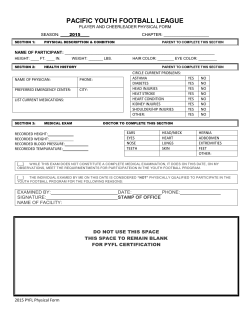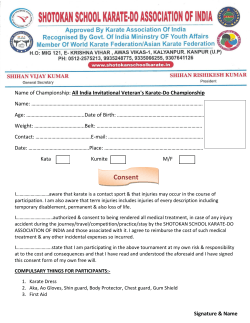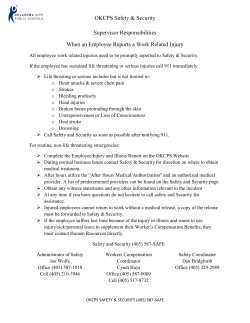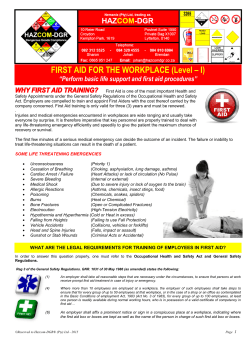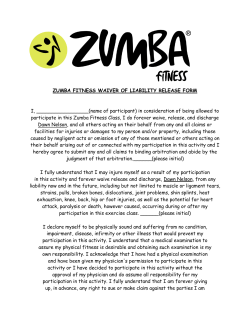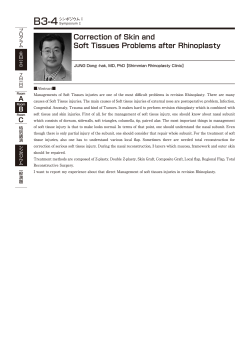
Injuries, ill-Health and fatalities in white water rafting and white water
Loughborough University Institutional Repository Injuries, ill-Health and fatalities in white water rafting and white water paddling This item was submitted to Loughborough University's Institutional Repository by the/an author. WILSON, I. ... et al., 2013. Injuries, ill-health and fatalities in white water rafting and white water paddling. Sports Medicine, 43 (1), pp. 65 - 75. Citation: Additional Information: • The nal publication is available http://dx.doi.org/10.1007/s40279-012-0007-8. Metadata Record: Version: at Springer via https://dspace.lboro.ac.uk/2134/17194 Accepted for publication Publisher: c Springer International This work is made available according to the conditions of the Creative Commons Attribution-NonCommercial-NoDerivatives 4.0 International (CC BYNC-ND 4.0) licence. Full details of this licence are available at: https://creativecommons.org/licenses/bync-nd/4.0/ Rights: Please cite the published version. Injuries, ill-health and fatalities in white water activities Injuries, Ill-Health and Fatalities in White Water Rafting and White Water Paddling; a Review. Accepted Version Published in: Sports Medicine (2013) 43:65–75 DOI 10.1007/s40279-012-0007-8 The final publication is available at link.springer.com http://link.springer.com/article/10.1007%2Fs40279-012-0007-8 Iain Wilson1, Hilary McDermott1, Fehmidah Munir2, Eef Hogervorst3 1 Work and Health Research Centre, School of Sport, Exercise and Health Sciences, Loughborough University, Loughborough, Leicestershire, LE11 3TU. England 2 Centre for Global Health and Human Development, School of Sport, Exercise and Health Sciences, Loughborough University, Loughborough, Leicestershire, LE11 3TU. England 3 Applied Cognitive Research Group, School of Sport, Exercise and Health Sciences, Loughborough University, Loughborough, Leicestershire, LE11 3TU. England I.S.Wilson@lboro.ac.uk H.J.McDermott@lboro.ac.uk F.Munir@lboro.ac.uk E.Hogervorst@lboro.ac.uk Word count: 3,504. No. of Tables: 4. Corresponding author: Mr Iain Wilson Work and Health Research Centre, School of Sport, Exercise and Health Sciences, Wavy Top Building, Loughborough University, Loughborough, Leicestershire, LE11 3TU. England, UK Tel +44 (0)1509 223083; Fax +44 (0)1509 223940 E-mail address: I.S.Wilson@lboro.ac.uk 1 Injuries, ill-health and fatalities in white water activities Injuries, Ill-Health and Fatalities in White Water Rafting and White Water Paddling; a Review. Table of Contents Abstract p.5 Acknowledgements p.5 1. Introduction p.6 2. Literature Search Methodology p.7 3. Findings p.8 3.1 Injuries p.9 3.1.1 White Water Paddling p.9 3.1.2 White Water Rafting p.10 3.1.3 Injury Rates p.11 3.2 Illnesses p.12 3.3 Fatalities p.13 4. Discussion p.13 5. Conclusion p.16 References p.17 Table I p.20 Table II p.21 Table III p.28 Table III p.30 2 Injuries, ill-health and fatalities in white water activities Abstract White Water (WW) activities such as paddling (canoeing and kayaking) and rafting are popular sports for recreational and professional participants. An increase in participation has been seen worldwide. However, these activities come with a risk of injury and even death if not conducted safely. A review was conducted to identify the types of injuries and ill-health which occur as a result of these activities. Injury and fatality rates were assessed to establish the risk attributed to these activities. Web of Science, PubMed, Ergonomics Abstracts and PsycINFO databases were searched and a total of sixteen published articles were identified and reviewed. The shoulders and back were the most vulnerable sites for injury in WW paddling. Injuries to the face and lower limbs were most common in WW rafters. However, injury rates are low and estimates are discussed. Due to different methods used across the studies, the reported injury rates are not comparable. Illnesses have been reported in WW activity participants including gastrointestinal illnesses and surfer’s ear. A relative paucity of studies regarding injuries and fatalities in WW activities was identified. Directions for future research are suggested and discussed. Key Words: Occupational Health; Work-related Injuries; Injury Rates; Outdoor Industry Acknowledgements There was no funding provider involved in the production of this paper. None of the authors have any conflicts of interest. All individuals who made substantial contributions to this work met the criteria for authorship. 3 Injuries, ill-health and fatalities in white water activities 1. Introduction Outdoor activities, mostly land and water based, have been used for recreational, educational, skill development and therapeutic purposes.[1] In the UK, it was estimated that between ten and 15,000,000 people participate in outdoor activities a year.[1] In 2009, between 60,500 and 88,000 employees worked within the outdoor industry sector to facilitate increasing participation rates.[1] Outdoor activities are also popular worldwide. In America, almost half of the population have participated in some form of outdoor activity.[2] Similarly, 64% of New Zealand Adults was estimated to have participated in at least one outdoor activity in 2008.[3] Adventure activities, such as White water canoeing, kayaking and rafting have shown to be especially popular.[2-4] Although popular, outdoor activities do carry a risk of injury or in rare cases death.[5,6] White water (WW) canoeing and kayaking, known as the umbrella term “WW paddling”, involves the use of a small craft to negotiate WW rivers. Canoes are knelt in and the paddler uses a single ended paddle. Kayakers sit in their craft and use a double ended paddle. WW rafting is an activity where (usually) between four and eight individuals use a single inflatable craft to negotiate a river. Individuals sit side by side and use a single bladed paddle to propel and steer the craft. This is both a commercial, recreational activity, supplied by providers, as well as competitive sport worldwide.[7] WW rivers are defined by water hydraulics formed by water falling over an uneven river bed.[8] Rivers are graded, ranging from I to VI (Table I), depending on the rate of fall of the water, the volume of water and the nature of the river bed.[8] Higher grades indicate more dangerous rivers, which are more technical to negotiate and/or have larger volumes.[8] [Table I here] In the UK, in 2010, over 2.75 million adults participated at least once in outdoor water sports[4] (demographics specific to WW are unavailable, as WW activities are just one aspect within the umbrella category of the activity). Canoeing was the most popular water sport with 4 Injuries, ill-health and fatalities in white water activities over 1 million individuals participating.[4] Almost 148,000 individuals paddle at least once a month in the UK.[9] Similar rates are reported elsewhere. In New Zealand, for example, canoeing was the 16th most popular activity compared to all activities.[3] In America in 2010 over 1.8million people participated in WW kayaking, an increase of almost half a million from the previous year.[2] America also saw an increase of over 100,000 participants in WW rafting between 2009 and 2010, totalling almost 4.5million participants.[2] However, WW paddling and rafting are associated with acute and chronic injuries.[5,6] Acute injuries are incidents of pain which occur rapidly due to a specific event or trauma. Chronic injuries are defined as pain that develops over a period of time, is persisting and long lasting and recurs over time. Injuries can occur at any site of the body, with the upper body being most at risk.[10,11] Overuse injuries that occur for prolonged periods of time can lead to more permanent issues.[12] In addition to injuries and fatalities, acute and chronic illnesses are also associated with WW activities such as surfer’s ear,[13] and gastrointestinal illnesses.[14,15] With an increase in participants in many countries worldwide, it can be anticipated that there could be a proportional increase in the injuries and potential illnesses occurring. Fiore[6] highlights that research examining injuries within WW activities has been relatively neglected, and there is a specific lack of prospective studies assessing true injury and fatality rates. This study reviewed the types of injuries experienced and details of fatalities which have occurred as a result from the participating in WW activities worldwide. Specifically, the frequency of such injuries and fatalities are examined and the methods used to report these estimates. Data from articles were synthesised to identify patterns in the literature in order to understand what is currently known. Due to the limited research in this area, this review will establish a foundation of knowledge for research to be built upon. 2. Literature Search Methodology 5 Injuries, ill-health and fatalities in white water activities A literature review was conducted to identify published articles from any country, on injuries and fatalities related to the WW paddling and rafting, published since 1990. The inclusion criteria included studies that reported any type of injuries, ranging from minor (e.g. contusions) to severe injuries requiring professional medical attention (e.g. dislocations), and fatalities which were a result of the WW activities stated. All levels of ability were examined, ranging from occasional, novice participants to qualified experts and professional competitors. Patterns in the cause of injuries and fatalities were reviewed as well as the frequencies of occurrence. The databases searched were Web of Science, PubMed, Ergonomics Abstracts and PsycINFO. These databases were searched using the following terms independently and combined ‘white water canoe*’, ‘white water kayak*’, ‘white water raft*’, ‘white water injury’, ‘white water morbidity’, ‘white water mortality’, ‘white water injury rates’, ‘white water fatality rates’, ‘white water acute’, ‘white water chronic’, ‘white water illness’ and ‘white water disease’. The term ‘white water’ was utilised to eliminate injuries associated with non-WW paddling and rafting. This study focuses on injuries, ill-health and fatalities. In addition to searching these databases, the references of identified journals were utilised to expand the search. 3. Findings A total of 16 published articles were identified which met the inclusion criteria. Articles were identified from five countries; eight from America, four from New Zealand, two from the UK, one from Ireland and one from Japan. Various methods of data collection were reported. Surveys were used in seven studies,[10,12-14,16-18] provider records were used in three studies,[19-21] hospital discharge data[22,23] were used in a further two studies, observation,[11] telephone interview,[15] tourist compensation claim data[24] and kinematic data[25] were identified in single articles. Samples ranged between 54-473 participants, of which between 53.5 and 89 per cent were male. 6 Injuries, ill-health and fatalities in white water activities The different types of injuries sustained through WW activities is summarised in Table II. [Table II here] It has been reported that the participants’ ability is associated with the type of injury sustained. Fiore and Houston,[16] reported that novices, defined as those competent on Grade I and II rivers, sustain more acute, impact related injuries, such as abrasions, lacerations, sprains, strains and fractures. Expert paddlers, on the other hand, defined as individuals who are competent on grade V and VI rivers, sustain more chronic, overuse injuries, such as tendonitis.[16] Acute and chronic injuries and injury rates have been examined in WW paddling and rafting, separately. No gender differences have been observed in any category, therefore all results apply to both males and females. 3.1 Injuries 3.1.1 WW Paddling A total of five papers were identified which discussed acute injuries associated with WW paddling.[10-12,16,18] The most frequent injuries reported were lacerations, sprains/strains, fractures and dislocations.[10-12,16,18] The majority of injuries were reported to have occurred whilst the paddler was in their boat.[16] Most lower-limb injuries occur when paddlers are ‘swimming’ after capsizing or during the hike to and from river access points.[11,16,18] Novice paddlers reported more lower limb injuries because they capsize more frequently.[16] Acute injuries that occurred tended to require medical attention. However, they were short-term and recovery was usually complete.[16] Chronic injuries associated with WW paddling were discussed in five identified papers.[10,12,16,18,25] These papers used either a survey[10,16,18] or a physical examination[12,25] to collect data on chronic injuries. The most frequently reported chronic injury was tendonitis which developed through overuse.[10,16,18] This was mostly observed in expert WW paddlers who frequently paddled[16,18] and was more common in professional competitors.[10] 7 Injuries, ill-health and fatalities in white water activities Kameyama et al[12] identified that multiple chronic injuries can result in deformation of the joints if not treated correctly. Deformation is an extreme example of chronic injuries. This specifically occurred in the shoulder joint, a vulnerable area of high stress when paddling. Wassinger et al[25] also highlighted that technique could contribute to chronic injuries in the shoulders. Poor technique could contribute to uneven movement in the scapula, creating a risk of tissue damage in the shoulder due to the unnatural movement. 3.1.2 WW Rafting A total of three papers were identified which discussed acute injuries associated with WW rafting.[11,20,22] The most common types of injury experienced by commercial WW raft users were abrasions, lacerations, sprains, strains and fractures.[11,20,22] Data collected for these studies were collected from either the WW rafting providers’ records[20] or hospital discharge records.[22] The face and lower body limbs were reported to be the most common sites of injury.[20,22] Injuries to these parts included lacerations, sprains, strains, fractures, contusions, dislocations and non-fatal submersion. All injuries reported, in the studies reported here, required medical attention. This was because the studies only examined provider[20] or hospital[22] data. In all papers, collision trauma was the most reported cause of injury. Unsurprisingly, this occurred as a result of colliding with obstacles on the riverbed, e.g. rocks, when the participant was ‘swimming’ (i.e. fell out of the raft). Collisions with other raft members’ equipment, e.g. paddle, was the other common form of collision trauma reported. Only one paper was identified which discussed chronic injuries associated with WW rafting.[17] Jackson and Verscheure[17] examined the occupational health of WW raft guides, specifically lower back pain. It was reported that chronic back pain was experienced by some WW rafting guides. The working practices associated with this injury were predominantly land based, with the loading and unloading of equipment and lifting rafts to be stored in stacks being the highest predictors of back pain. Jackson and Verscheure[17] 8 Injuries, ill-health and fatalities in white water activities speculated that this could be due to the technique used, lifting and throwing a raft requires a rapid twisting motion of the torso, which can be harmful if it is regularly repeated, which it is as it is part of the daily routine for a raft guide. However, back pain was reported to be short lived and rarely resulted in absenteeism. 3.1.3 Injury Rates Injury rates are summarised in Table III. A total of four papers were identified reporting injury rates in WW paddling.[10,12,18,19] In-house injury data was used in one study,[19] the remainder utilised survey data to calculate injury rates.[10,12,18] All studies calculated the injury rates by dividing the number of injuries reported by the unit of measurement. However, injury rates were reported using three different units of measurement; injuries per 1,000 participant hours,[19] injuries per participant[12,18] and injuries per year.[10] For example, in New Zealand, an injury rate of 0.014 per 1,000 participant hours was observed.[19] In the USA 677 injuries were observed in 388 participants, creating a rate of 2.1 injuries per participant in recreational paddlers.[18] This was more than triple the 0.69 injuries per participant reported in Japanese paddlers (n=288).[12] The studies which reported injuries per participant did not provide a timescale, therefore an accurate estimate cannot be calculated. However, one study[10] which examined Olympic paddlers reported 0.46 injuries per year (n=57). A total of four papers were identified as reporting injury rates in WW rafting.[17,19,20,22] WW rafting provider records,[19,20] hospital data[22] and a survey,[17] were the methods of data collection. Commercial WW rafting provider records in the USA indicate an injury rate of 0.26 per 1,000 participants (26.3 per 100,000 participants).[20] Provider records in New Zealand report an injury rate of 0.54 per participant 1,000 hours.[19] Hospital records in New Zealand suggest that 1.04-1.81 injuries occur to every 100,000 participants.[22] The hospital record data suggests that very few injuries require hospital treatment. Although acute injury rates were predominately reported from record data, one study examined the prevalence of chronic back pain.[17] Jackson and Verscheure[17] reported a prevalence of back pain among 9 Injuries, ill-health and fatalities in white water activities American WW raft guides that was similar to the general population. This suggests that raft guides are at no additional risk of developing back pain compared to the general population. [Table III here] 3.2 Illness In addition to injuries, WW users are at risk of contracting illnesses related to water activities (Table II). A total of three papers were identified directly examining ill-health in WW paddlers.[13-15] Of these, two papers examined acute illness induced by swallowing contaminated water.[14,15] The remaining study examined chronic illness as a result of repeat exposure to cold water.[13] Lee et al[14] assessed the relationship between water quality and participant health, samples of water were collected and analysed alongside questionnaire data in the UK.[14] Water samples were examined on an hourly basis. Questionnaires were available for users participating on the test days (n=473). Ingesting river water, whilst bacteria levels were high, were the strongest predictors of ill-health. Frequent users of the WW facility reported fewer cases of illness than infrequent users. Boland et al[15] explored an outbreak of Leptospirosis, following a canoeing competition in Ireland. Telephone interviews were conducted with 62 competitors of this competition. A total 18 participants reported symptoms of gastrointestinal illness following the competition. Of these, there were 6 cases of Leptospirosis identified. Similar to Lee et al,[14] ingesting contaminated water was the highest reported predictor of contracting the illness. External Auditory Canal Exostoses (EACE) also known as surfer’s ear, is a chronic illness associated with WW kayaking.[13] The presence of EACE was assessed using a survey and medical examination.[13] Over two thirds of the kayakers (n=92) in this study displayed symptoms of EACE, this was compared to 1.7% of the rock climber control group (n=65).[13] EACE was associated with years paddling, being observed in 90.6% of kayakers who had 10 Injuries, ill-health and fatalities in white water activities paddled for 10 years or more. Severe cases of EACE (canal obstructed >67%) were only observed in individuals who had participated greater than 10 years. It was suggested that ear plugs may benefit paddlers, however at the cost of impaired hearing whilst in use.[13] 3.3 Fatalities Table IV summarises the four papers which were identified as reporting fatalities in WW paddling and WW rafting. All data referring to fatality rates in WW activities have been generated from the USA[21] and New Zealand.[17,22,23] Two papers reported comprehensive rates (per 100,000 participants per annum) for WW paddling[21] and WW rafting[22] and the other two papers only reported the number of deaths that occurred, with no additional, contextual information to allow fatality rates to be calculated.[17,23] In WW rafting, drowning and submersion accounted for 94% of fatalities.[22] Other fatalities occurred as a result of an accident to the watercraft or an unspecified fall in water transport.[22] Fatalities seem rare, hospital data in New Zealand, reported a rate of 0.16-0.27 per 100,000 participants per annum in WW rafters.[22] In the USA, managed river access facility data were used to calculate fatality rates for WW paddlers.[21] A rate of 2.9 fatalities per 100,000 participants per annum was reported.[21] Details of how the fatalities occurred in WW paddlers were not included. Although it has been reported that more fatalities occurred in WW rafting,[23,24] differences in participation numbers could also explain the observed differences in the fatality rates. [Table IV here] 4. Discussion This review identified a total of 16 published articles. The main results identified through the reviewed papers were that injuries are most likely to be sustained in the upper body. Expert, particularly competitive WW users are more at risk of sustaining chronic injuries than novices who occasionally partake in the activities. The injury rates for recreational participants 11 Injuries, ill-health and fatalities in white water activities appear to be relatively low, around 4.5 per 1,000 participant days for WW paddling[18] and 26.3 per 100,000 participants in WW rafting.[20] It is important to be cautious when considering the accuracy of these rates for two reasons. Firstly, sample sizes and methods utilised to collect data were different, meaning that injury rates, risks to health and fatality rates could not be directly compared. Second, the definitions of the term ‘injury’ vary between studies. Schoen and Stano[18] allowed for self-report of injuries in a survey. This could lead to over-reporting, particularly when comparing these data to injuries that required medical attention and were recorded officially by providers.[20] All WW rafting injuries were defined as requiring medical attention, therefore any injury that was perceived as not requiring medical attention were excluded from these rates. This could have occurred if the injury was not considered severe enough to report. Cultural and/or environment differences may further influence this decision process. This review suggests that acute injuries are associated often with hospitalisations and medical treatment.[18,22] However, chronic injuries can be just as severe even if they occur less frequently such as joint distortions.[12] The only interventions that were identified in this review to reduce chronic injuries were balanced training to avoid overusing specific muscle and joint areas and adequate rest.[12] However, the extent to which guidelines are adhered to currently remains unknown. The review also identified that illness among WW users is most likely to occur following a flood where contaminants may be present in the water.[14,15] Improved hygiene awareness may be beneficial in reducing illness contracted in this way. Although Governing Bodies such as the British Canoe Union [BCU] provide information regarding illness and disease associated with WW activities, this information is not always accessed by WW users.[26] However, Philipp’s report is now dated and a more recent examination of the impact of health related information, advice, and guidelines to prevent illness may be beneficial. 12 Injuries, ill-health and fatalities in white water activities Weiss[11] suggested that appropriate equipment and correct techniques can prevent injuries, particularly among novices. For example, a correct paddling technique can help prevent a capsize incident and thus avoid potential injury or fatality. Most WW rafting injuries arise from a collision. Users can collide with either other users, equipment or obstacles in the water.[11,20,22] Whisman and Hollenhorst[20] suggest a number of preventative measures to reduce injury prevention. These include face guards and limited number of users per raft.[20] Cooper et al[13] additionally suggests the use of ear plugs to protect against the development of EACE. The extent to which personal protective equipment (PPE) is effective in preventing injuries or ill-health to WW users has not been empirically tested. Unsurprisingly, in this review, drowning was reported as the most common cause of death in WW activity users. Lower fatality rates were reported for rafting reported as opposed to paddling. One explanation might be that WW rafting is a commercially organised activity lead by a professional guide, whereas WW paddling is a recreational activity which relies on the individual’s ability as opposed to professional guidance. In addition, WW paddlers have lower volume boats compared to rafts, therefore these are more likely to become submerged, particularly on higher grade rivers where the water is more turbulent. The articles reviewed here utilised various methods to assess injury types, including surveys, record data and medical examinations. Surveys are a good technique to collect data from a larger sample, however there can be inconsistencies with interpretations of injury. For example, muscle ache could be interpreted as a strain by some and fatigue by others. In addition, the retrospective nature of data collection may mean some injuries are not recalled or are recalled inadequately. Record data may be more accurate as it is collected at the time of injury or shortly afterwards. There may also be medical assessments which inform these records. However, medical assessments are limited to those whose injuries require treatment. Less serious injuries will not be recorded. However, a number of studies have conducted medical examinations to identify and assess injuries among WW paddlers who do not necessarily report injury.[12,13] Such studies provide a more objective 13 Injuries, ill-health and fatalities in white water activities assessment. To date, there is no comprehensive way of recording injuries sustained among WW users. Utilising a mixture of these methods may help build a more comprehensive understanding of injuries experienced. Comparing survey data to record data may provide insight into the types of injuries which are perceived as requiring medical intervention. None of the articles distinguished between natural rivers and ‘man-made’ river facilities. A comparison examining the injuries sustained on a natural river compared to ‘man-made’ facilities may reveal differences in injury types. To our knowledge, this is an issue that has not been addressed in the literature. There are unlikely to be rocks in a ‘man-made’ facility and this is an important issue that needs to be considered. In addition, personality factors have not been investigated in previous studies and may be a predictor of reporting behaviour and/or risk taking. Adventure tourism has grown as an industry in New Zealand, the USA, in Europe and elsewhere worldwide. It may be that as participant rates increase,[2-4] injury rates will change in line with this increase. Therefore, much more attention needs to be paid to ensure these activities are as safe as possible for all those who participate. 5. Conclusion WW adventure activities are developing with increased numbers participating each year.[2] The upper body is the most prone site for injuries, which can be either acute, such as abrasions, or chronic, such as back pain. Novice paddlers and commercial WW rafters appear to obtain more abrasions and impact injuries from falling out of their boat or craft. Chronic injuries are more prevalent in expert paddlers and raft guides. Correct equipment and techniques can aid the prevention of any type of injury. Considering this, injuries are relatively rare in both WW activities, especially those which are fatal. Research examining occupational raft guides and other paddling tourist destinations should be further developed and conducted. 14 Injuries, ill-health and fatalities in white water activities References 1. SkillsActive. The Outdoors Survey 2009. Available at: http://www.skillsactive.com/assets/0000/6348/SkillsActiveTheOutdoorsSurvey2009_FINALR eport_Jun2010.pdf. [Accessed Nov 29, 2011] 2. Outdoor Industry Association [OIA]. Outdoor Recreation Participation Report 2011. Available at: http://www.outdoorindustry.org/research.php?action=detail&research_id=146. [Accessed Oct 11, 2011] 3. Sport and Recreation New Zealand [SPARC]. Sport and Recreation Participation Levels: Findings from the 2007/08 Active NZ Survey. Available at: http://www.activenzsurvey.org.nz/Documents/Participation-Levels.pdf. [Accessed Dec 08, 2011] 4. Royal Yachting Association [RYA]. Watersports and Leisure Participation Survey 2010. Available at: http://www.britishmarine.co.uk/upload_pub/WatersportsandLeisureOmnibusreport2010.pdf. [Accessed Dec 08, 2011] 5. Chalmers D, Morrison L. Epidemiology of non-submersion injuries in aquatic sporting and recreational activities. Sports Med 2003;33(10):745-770. 6. Fiore DC. Injuries associated with whitewater rafting and kayaking. Wilderness Environ Med 2003;14(4):255-260. 7. British Canoe Union [BCU]. White Water Rafting Homepage. Available at: http://bcu.org.uk/our-sport/white-water-rafting/. [Accessed Oct 24, 2011] 8. Attenburrow M. White Water Safety and Rescue. In: Rowe R, editor. Canoeing Handbook: the official handbook of the British Canoe Union. (2nd ed.). UK: Biddles Limited; 1993. p. 223-247. 15 Injuries, ill-health and fatalities in white water activities 9. Sport England. Active People Survey (APS) Results for Canoeing. Period : APS2 (Oct 07/Oct 08) to APS5 (Oct 10/Oct 11). Available at: http://www.sportengland.org/search.aspx?query=active+people+canoeing. [Accessed Jan 13, 2011] 10. Krupnick JE, Cox RD, Summers RL. Injuries sustained during competitive white-water paddling: a survey of athletes in the 1996 Olympic trials. Wilderness Environ Med 1998;9(1):14-18. 11. Weiss EA. Whitewater Medicine. J Wilderness Med 1991;2(3):245-252. 12. Kameyama O, Shibano K, Kawakita H, Ogawa R, Kumamoto M. Medical check of competitive canoeists. J Orthop Sci 1999;4(4):243-9. 13. Cooper A, Tong R, Neil R, Owens D, Tomkinson A. External auditory canal exostoses in white water kayakers. Br J Sports Med 2010;44(2):144-147. 14. Lee JV, Dawson SR, Ward S, Surman SB, Neal KR. Bacteriophages are a better indicator of illness rates than bacteria amongst users of a white water course fed by a lowland river. Water Sci Tech 1997;35(11-12):165-170. 15. Boland M, Sayers G, Coleman T, Bergin C, Sheehan N, Creamer E, et al. A cluster of leptospirosis cases in canoeists following a competition on the River Liffey. Epidemiol Infect 2004;132(2):195-200. 16. Fiore DC, Houston JD. Injuries in whitewater kayaking. Br J Sports Med 2001;35(4):235241. 17. Jackson DM, Verscheure SK. Back pain in whitewater rafting guides. Wilderness Environ Med 2006;17(3):162-170. 18. Schoen RG, Stano MJ. Year 2000 whitewater injury survey. Wilderness Environ Med 2002;13(2):119-124. 16 Injuries, ill-health and fatalities in white water activities 19. Bentley TA, Page SJ, Laird IS. Safety in New Zealand's adventure tourism industry: The client accident experience of adventure tourism operators. J Travel Med 2000;7(5):239-245. 20. Whisman SA, Hollenhorst SJ. Injuries in commercial whitewater rafting. Clin J Sport Med 1999;9(1):18-23. 21. Wittmann L. Kayaking is safer than you might think (really!). American Whitewater 2000(SEP-OCT):100-101. 22. O'Hare D, Chalmers D, Arnold NA, Williams F. Mortality and morbidity in white water rafting in New Zealand. Inj Control Saf Promot 2002;9(3):193-8. 23. Bentley T, Page S, Meyer D, Chalmers D, Laird I. How safe is adventure tourism in New Zealand? An exploratory analysis. Appl Ergon 2001;32(4):327-338. 24. Bentley T, Macky K, Edwards J. Injuries to New Zealanders participating in adventure tourism and adventure sports: An analysis of accident compensation corporation (ACC) claims. New Zeal Med J 2006:119(1247):U2359. 25. Wassinger CA, Myers JB, Sell TC, Oyama S, Rubenstein EN, Lephart SM. Scapulohumeral kinematic assessment of the forward kayak stroke in experienced whitewater kayakers. Sports Biomech 2011;10(2):98-109. 26. Philipp R, King C, Hughes A. Understanding of Weil's disease among canoeists. Br J Sports Med 1992;26(4):223-7. 17 Injuries, ill-health and fatalities in white water activities Table I Definition of the River Grades. Adapted from the BCU Handbook [8] Grade Definition Grade I Low difficulty river with simple obstructions and regular streams and waves. Hydraulics are small and cannot hold objects. Grade II Moderate difficulty river with simple obstructions and irregular streams and waves. Hydraulics are medium sized, some may hold small objects. Small drops are possible. Route is clear and passage free. Grade III Difficult river with high, irregular waves and larger hydraulics. Hydraulics will hold objects and push boats around. Stream will have drops and numerous obstructions. Route is still recognisable. Grade IV Very difficult river with continuous waves and hydraulics. Hydraulics will hold objects with strong force. Numerous obstructions in the stream, including boulders with undercut currents. Route is not always recognisable, inspection is recommended. Grade V Extremely difficult river with narrow passages, steep gradients and drops. Hydraulics are more extreme than Grade IV rivers. Access to the river is usually difficult due to steep banks. Inspection prior to running is essential. Grade VI High risk rivers which are generally impossible to run; certain water levels are required to negotiate. Highly recommended to portage around these sections of river. 18 Injuries, ill-health and fatalities in white water activities Table II A summary of injuries and ill-health reported in White Water (WW*) Adventure Activities. Population N Age Type of (Male) (Years) Study/Data (Mean+SD) Source 34 (+11.8) Survey Paddlers in the USA Site(s) Injury/Ill-health Possible Severity Intervention Comments References Type(s) Cause(s) Shoulder most Sprain, Carelessness. Medical Generalisations 10 (Response vulnerable. tendonitis, Overuse injuries. treatment was between professional Rate 19.6%) Head, neck, chronic, bruise, required for and amateur back, arms, fracture, 19.6% of populations should be elbows, wrists, dislocation and injuries taken with caution. No legs, knees, laceration. reported. clear definition of hands and feet. Cold injury, ‘injury’. frostbite, heat, Injuries have been dehydration, associated with insect bite, near specific sites on the drown, drown. body. Suggestions WW Paddling Competitive WW Rafters and Paddlers 54 (75%) No info. No info. None. Observation Entire body at Abrasions, Inappropriate Minor to Use of correct Based on personal and personal risk. lacerations, equipment or fatalities. equipment and experience. strains, sprains, none at all. techniques. Conclusions were not bone fractures Poor risk Appropriate risk based on any study and breaks, assessment. assessment. based evidence. dislocation of Poor technique Seek expert experience 11 19 Injuries, ill-health and fatalities in white water activities Population N Age Type of (Male) (Years) Study/Data (Mean+SD) Source Site(s) Injury/Ill-health Possible Severity Intervention Type(s) Cause(s) Suggestions joints, drowning. and levels of advice before skills. paddling a Comments References 12 river. Japanese Canoe 417 Slalom Team (73.4%) WW Paddlers 392 (83%) 26 (+2.9) 34 Survey. Lower back, Numbness, Stress from the If untreated it Sufficient rest Objectively measured Medical shoulder, limited paddle stroke is can lead to between injuries through Examinations. elbow, knees. movement, pain, focused on the fractures and training medical examinations. fractures, shoulder, elbow deformation. sessions. dislocations, and and lower back Strengthening osteoarthritis resulting in the stability deformity. overuse injuries. muscles. Survey Upper body, Abrasions Striking objects 51% of the distributed specifically Tendonitis was the most injuries more impact injuries online, by post shoulders. Contusions reported cause of required from falling out of their Dislocations injuries. Stress medical boats. Expert paddlers from the force of attention. developed chronic the water causing 96% of injuries injuries mostly from injury followed. had either a overuse. and face to face. None. Novices developed 16 good or complete 20 Injuries, ill-health and fatalities in white water activities Population N Age Type of (Male) (Years) Study/Data (Mean+SD) Source Site(s) Injury/Ill-health Possible Type(s) Cause(s) Severity Intervention Comments References Subjective definition of 18 Suggestions recovery. WW Paddlers 319 No info. (72%) Mail out mail Shoulder/arm Laceration, Accidents whilst Non serious to None. back survey Wrist/hand contusions and transporting requiring ‘injury’, compared to Head/face/neck abrasions were boats. medical medical assessment. Knee most common Rodeo and treatment. acute injuries. Slalom disciplines Tendonitis, are at more risk of sprains/strains developing were most injuries. common chronic injuries. Expert WW Paddlers 25 (92%) 34.1 (+9.4) Three Shoulder Potential for Thrust motion of dimensional acute and paddle stroke. scapula and chronic injuries Unspecified Further Association found research. between shoulder 25 stability and paddle humeral stroke movement. kinematic data. Further research required to explore this association. WW Rafting 21 Injuries, ill-health and fatalities in white water activities Population WW Rafters and N Age Type of (Male) (Years) Study/Data (Mean+SD) Source No info. Personal experience and No info. Paddlers Site(s) Injury/Ill-health Possible Severity Type(s) Cause(s) Entire body at Abrasions, Inappropriate Minor to risk. lacerations, equipment or fatalities. observation strains, sprains, data Intervention Comments References Use of correct Based on personal 11 equipment and experience. none at all. techniques. Conclusions were not bone fractures Poor risk Appropriate risk based on any study and breaks, assessment. assessment. based evidence. dislocation of Poor technique Seek expert joints, drowning. and levels of advice before skills. paddling a Suggestions river. WW Raft Guides 390 (No No mean. Mail-out, Mail- Lower Back Chronic back Lifting, loading Short lived. Use Did not included info.) Range 18- back survey. Shoulder pain and uploading Few needed mechanical individuals who may 60+ (Response Elbow equipment. medical lifts. have retired due to treatment. Lift equipment injury. Low response in groups rate. Only study Rate 15.5%) 17 assessing occupational health. Commercial WW 30 raft users No info. WW Raft Face most Lacerations, Collisions with Majority of Fewer Face guards can Providers provider† common site. sprains/strains, rocks, equipment injuries were individuals per restrict vision which † records in Upper and fractures, and other rafters. minor. raft. can be an additional 20 22 Injuries, ill-health and fatalities in white water activities Population N Age Type of (Male) (Years) Study/Data (Mean+SD) Source America. Site(s) lower limbs. Injury/Ill-health Possible Type(s) Cause(s) Severity Intervention Comments References Suggestions contusions and Face guards dislocations in with the WW rafters. helmets. None. hazard. Commercial WW 215 30.4 Hospital Lower limbs Fractures Unspecified water All injuries A standardised method Rafters observati (+11.7) discharge data most common Non-fatal transport resulted in of measuring injuries. ons site, specifically submersion accident. hospitalisation. Injuries which did not (53.5%) the feet. Sprains/strains Submerged after require medical Face and Contusions falling out of the attention have gone shoulder. Dislocations raft. unreported. Accident to Explanations of the watercraft causes lack details. 22 causing injury. Unspecified fall in water transport. Illness WW Kayakers 92 (75%) 29.3 Questionnaire (+8.72) External auditory Exposure to 69.5% of The use of ear and Physical canal exostoses sudden cold kayakers plugs reduce Examination. (EACE) water. Frequency showed symptoms of and years of symptoms EACE, however Comparison to Ear 13 23 Injuries, ill-health and fatalities in white water activities Population N Age Type of (Male) (Years) Study/Data (Mean+SD) Source Site(s) Injury/Ill-health Possible Type(s) Cause(s) Severity Intervention Comments References Better hygiene Regular users 14 Suggestions a control group experience were compared to these may of climbers. both positively 1.7% of the create correlated with control group. communication EACE. 7.8% kayakers issues. had severe case of EACE. WW Rafters and 473 (No Paddlers info.) No info. Survey. Gastrointestinal River water illness ingestion. after experienced illness tests on water Consuming food participation. less frequently than samples and drink with those on daytrips. contaminated Possible explantions hands. include: frequent users Water quality Gastrointestinal No info. are more experienced and skilled therefore become submerged less frequently and ingest less water. Also frequent users tended to live local and 24 Injuries, ill-health and fatalities in white water activities Population N Age Type of (Male) (Years) Study/Data (Mean+SD) Source Site(s) Injury/Ill-health Possible Type(s) Cause(s) Severity Intervention Comments References Suggestions therefore did not consume food directly after participation. WW Canoeing 62 (89%) No mean. Telephone competitors in Median = questionnaire. Ireland Leptospirosis Swallowing more 18 individuals A total of 62 of 69 than one mouthful reported competitors were 22 (Range of contaminated illness. 6 interviewed over the = 11-43) river water. confirmed telephone. A good Increased rainfall cases of sample from this and release of leptospirosis. specific event. hydroelectric However, because water. such a specific event, 15 findings are difficult to generalise. † A Provider is a commercial organisation which sells adventure activities. *WW = White Water 25 Injuries, ill-health and fatalities in white water activities Table III A summary of injury rates reported in White Water (WW*) Adventure Activities Population N (Male) Type of Study/Data Injury Rates Injury Severity Reference A total of 271 injuries were reported. Medical treatment was required for 19.6% of all injuries reported. 10 12 Source WW Paddling Competitive 54 (75%) Survey Paddlers in the An overall rate of 0.08 per participant USA per year. Japanese 417 (73.4%) Survey and Medical 229 of the 417 reported 288 problems. Numbness, limited movement, pain and dislocations. The medical Examinations. 22.5% experienced back pain. examination identified fractures and osteoarthritis deformity from Canoe Slalom 21% experienced shoulder pain. overuse. Team An overall rate of 0.69 per participant. Professional Recreational 319 (72%) paddlers. Mail out, mail back 388 acute injuries reported (1.2 per Medical attention was required for 47% of acute and 36% of chronic survey. person). injuries. 286 chronic injuries reported. Shoulder and arm were the most acute injuries requiring medical A rate of 4.5 per 1,000 participant attention. days. Back, chest and hip injuries had the longest duration. 77.4% experienced back pain. 7.4% missed work. 18 WW Rafting WW Raft Guides in America 390 Mail-out, Mail-back survey. 17 20.8% experienced back pain >1 week. Lifting and (un)loading of equipment were the best predictors of back pain. 26 Injuries, ill-health and fatalities in white water activities Population N (Male) Type of Study/Data Injury Rates Injury Severity Reference Survey to access Kayakers 0.01 and Rafters 0.54 per Injuries resulting in hospitalisation for greater than 48hours were defined 19 Provider records of 1,000 participant hours. as severe. 0.26 per 1,000 participants. Sprains/strains (20%) Source WW Kayakers 142 and Rafters in Providers † New Zealand Commercial injuries. 30 Providers† WW raft users WW Raft providers in America 20 Lacerations (20%) in America Contusions/bruises (18%) Abrasions (11%) Fractures (11%) Dislocations (4%) Unspecified (8%) Unreported (9%) Commercial 215 Hospital discharge Overall rate of 1.04-1.81 per 100,000 All injuries reported were injuries which resulted in hospitalisation. WW rafters in hospitalisatio records over a 14year participants. Mean hospitalisation per annum 15.4 (SD=6.0). Range 7-25. New Zealand ns identified period from the New (53.5%) Zealand Health 22 Information Service (NZHIS) † A Provider is a commercial organisation which sells adventure activities. *WW = White Water 27 Injuries, ill-health and fatalities in white water activities Table IV A summary of fatality rates reported in White Water (WW*) Adventure Activities Population Type of Study/Data Fatality Rates Common Causes Comment Reference 2.9 per 100,000 participants per annum. Not specified. This is an estimate as the actual number of 21 Source WW Paddling Recreational WW Data collected from paddlers managed river participants was unknown. Does not account facilities. for paddlers who use unmanaged rivers. WW Rafting Commercial WW rafters Hospital records over 33 fatalities reported in 14years (81.8% Drowning and Hospital records are an accurate measure of in New Zealand a 14year period from males). submersion were the fatality rates, especially when compared the New Zealand 0.16-0.27 per 100,000 participants per most common cause against commercial usage. Health Information annum. of death (94%). Service (NZHIS) 22 Accident to watercraft causing injury (3%) and unspecified fall in water transport (3%) were the other causes of death. International Tourist WW Hospital records over 6 WW Rafting fatalities Rafters and Paddlers a 14year period from 4 WW Kayaking fatalities the New Zealand Not specified No information on participant numbers meant 23 a fatality rate could not be calculated. Tourist data, therefore natives not included in 28 Injuries, ill-health and fatalities in white water activities Population Type of Study/Data Fatality Rates Common Causes Comment Reference Source Health Information these figures. Service (NZHIS) WW Rafters and Tourist Compensation 0 WW kayak/canoeists Paddlers Claim Data in New 2 WW rafters Not specified Only accounts for those individuals who 24 claimed on their insurance. Zealand *WW = White Water 29
© Copyright 2025
